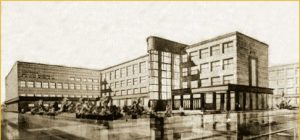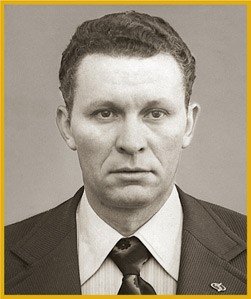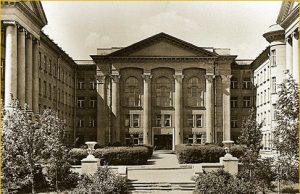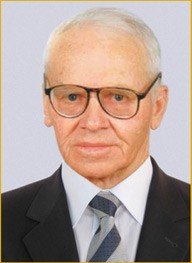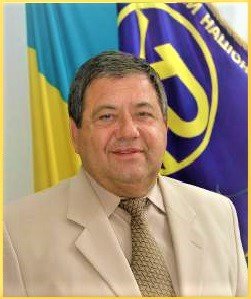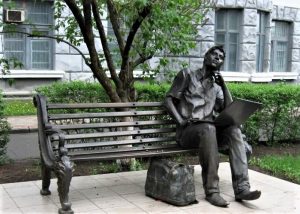The history of Kharkiv National University of Radio Electronics is definitely unique. It might be difficult to find a higher education institution at the territory of the former USSR that would have gone through such metamorphoses in such a short time.
It appeared in 1930 as an Institute of Construction (since 1933 – Institute of Civil Engineering). The famous Kharkov architect, Academic of Architecture Oleksii Beketov, contributed a great deal of inexhaustible energy to its creation. A new educational institution was created on the basis of the Faculty of Civil Engineering of Kharkiv Polytechnic Institute and the Faculty of Architecture of Kharkiv Institute of Arts. Shortly afterwards, in 1934, KhICE students began studying at their new building, at Shatylivka.
At that time the Honored Worker of the USSR Science, the Head of the Department of Astronomy Mykola Yevdokimov and the Honored Worker of the USSR Arts Oleksii Beketov were working among the teaching staff. For a few years, the Department of Physics was headed by the prominent scientist, Professor Kyrylo Synelnykov. Olexander Usikov, the future director of the Institute of Radiophysics and Electronics of the Ukrainian SSR Academy of Sciences was teaching at this department. The outstanding architects: Professor O.G. Molokin, Associate Professors G.O. Yanovytskyy, Ye.A. Lymar, Ya.A. Steinberg, R.M. Friedman worked at the Department of Architectural Design as well as others, who made a significant contribution to the development of Kharkiv.
In the ten pre-war years, about three thousand specialists graduated from KhICE.
In 1944 our educational institution was reorganized into Kharkov Mining and Industrial Institute. Along with the training of specialists in the construction and operation of mine equipment, the Institute participated in the restoration of the Donbas plants, assisted in the issues of using construction materials, industrial transport, architecture, mining.
At that time, Professors, Doctors of Physical and Mathematical Sciences V.F. Brzechko, Ya.L. Heronimus, B.P. Ostashchenko-Kudriavtsev, A.F. Serdobynskyy; Corresponding Member of the USSR Academy of Sciences A.O. Slutskin; Doctors of Engineering F.O. Bieliakov, S.G. Wesselman, M.G. Malyshevskyy, K.V. Ponko; Corresponding Members of the USSR Academy of Sciences A.P. Filippov, S.Yu. Freifeld; Professors O.M. Ginsburg, G.Y. Deshalit, O.O. Kokel, R.V. Kutepov, Yu.M. Leibfreid, D.M. Tamarin, M.S. Cherkassov, D.S. Cherkes worked at KhMII.
The need for training specialists in the mining professions was gradually increasing, and since 1947 Kharkiv Mining and Industrial Institute had become a purely Mining Institute, where the major Faculties were those of Mine Construction, Mining, Mining and Electromechanical, Industrial Transport.
For the first time in the USSR, Kharkiv Mining Institute began to train specialists in automation of mining enterprises. In the 1957/58 academic year, the training of mining power engineers in the field of automation had begun, and two years later there was the first graduation of 28 mining engineers in the field of mine automation and telemechanics. Among them, there was Valentin Svyrydov, the future rector of Kharkov Institute of Radio Electronics.
At that time, the development of circuits and means of automation, telemechanics of production processes, machines, mechanisms and communication at coal mines had already become relevant for Kharkiv Mining Institute.
Among the well-known graduates of the KhMI were Volodymyr Ivashko, Yuri Voievodin, Mykola Bolotskyy, Yurii Stadnychenko, Leonid Tatarenko.
In 1962, Kharkiv Institute of Mining Engineering, Automation and Computing Technics was established on the basis of the KhMI due to the growing need of specialists in radio electronics and electronic equipment. At the same time, two new faculties were created Radio Engineering and the Faculty of Automation of Production Processes in Mining Industry. The first department of a new profile – computer technology and industrial electronics – was created at the Faculty of Radio Engineering.
In September 1963, the Faculty of Radio Engineering was established, and in 1964 – the Faculty of Electronics.
Most of the scientific work of the Institute was an integral part of research carried out at the national level and included in the plan of development of science and technology in the country. The most important research were led by Professors V.P. Shestopalov, V.L. Rvachev, P.P. Nesterov, S.G. Wesselman, Associate Professors O.A. Volkov, V.O. Mykhailov, V.D. Karpukhin, Ye.O. Lytvynenko, O.I. Tereshchenko.
In 1966 the last reorganization of our educational institution took place: KhIMEACT was transformed into Kharkov Institute of Radio Electronics. The Faculty of Radiophysics was created.
In 1968, the Departments of Electronics and Radiophysics merged into the Faculty of Electronics.
The last chord of structural change was in February 1971 when the Faculty of Radio Equipment Designing was created.
In KhIRE the team of professors changed. During 1966–1969, Doctors of Physical and Mathematical Sciences, Professors S.D. Berman, B.I. Verkin, L.M. Gluskin, V.L. Rvachev, O.O. Soloviov, V.P. Shestopalov worked here, as well as Doctors of Engineering A.O. Abramian, S.G. Wesselman, O.A. Volkov, Ye.Ya. Ivanchenko, I.V. Kuzmin, A.Ya. Leikin, O.I. Tereshchenko; Doctor of Philosophy M.Ye. Dobruskin, O.P. Mamalui; Professors D.S. Kolobkov, Ye.V. Inopin, V.G. Chervov.
Scientific research were actively carried out at KhIRE. Scientists at the Department of Basics of Radio Engineering, led by Professor B.L. Kashcheiev, developed a unique highly sensitive computerized equipment complex “MARS” (Meteor Automated Radar Station), created an electronic orbital catalog of 250,000 radio meteoroids (1992-1998). It is worth noting the great contribution of Honored Scientist, Doctor of Engineering B.L. Kashcheiev in the development of national science. He was a member of the International Astronomical Union, an Honorary member of the Ukrainian Astronomical Association, Chairman of the Meteor Section of the Interdepartmental Geophysical Committee under the Presidium of the USSR Academy of Sciences, delegate and participant in international scientific conferences and assemblies, co-author of 11 monographs and more than 300 publications. In 1994, as a co-author of the monograph “Meteors and Meteor Matter”, he was awarded the M.P. Barabashov NASU Award.
A significant contribution to the development of the astronomical direction at the B.L. Kashcheiev Scientific School of Meteorological Radar Ranging was made by V.V. Fedynskyy, I.S. Astapovych, A.N. Symonenko, V.N. Lebedynets, N.O. Novosiolova, O.O. Tkachuk, Yu. I. Voloshchuk and others. Since the 1980s, the main leader and chairman of the astronomical direction of the B.L. Kashcheiev Scientific School was Doctor of Engineering, Professor Yu.I. Voloshchuk.
The scientific and technological achievements of the University scientists in the astronomical direction, led by Yu.I. Voloshchuk and B.L. Kashcheiev, had been highly estimated at the national and international level. In 1994, these achievements were honored with the M.P. Barabashov Award of the Presidium of the Academy of Sciences of Ukraine. In 1999, 2001, 2002, the three small planets were named “Kashcheiev”, “KhTURE”, and “Voloshchuk”. In 2004, the status of the national property of Ukraine was given to the Experimental Meteor Complex of the University at the countryside polygon in the Balaklia district of Kharkiv region.
The 70-80s marked the improvement of the material and technical base of the Institute. The second computer center was created, seven ЕСМs were installed, “Ural-4”, “Ural-2”, “Luch”, “Nairi”, and eight analogue MN-7 machines were added to the equipment fleet. In 1971, the Institute purchased the Ural-14D machine, created a specialized laboratory with a fleet of keyboard ЕСМs for 30 workplaces.
In 1981, KhIRE was awarded the Order of the Red Banner of Labor for the training of qualified specialists and the development of scientific research.
In 1982, KhIRE was named after the eminent scientist in the field of rocket and space technology, Academic Mykhailo Yangel.
During 1980–1985, Doctors of Physical and Mathematical sciences, Professors L.M. Gluskin, O.G. Shein; Doctors of Engineering A.G. Yevdokymov, Ye. Ya. Ivanchenko, and B.L. Kashcheiev (Honored Science and Technology Worker, 1980), M.D. Kolpakov, M.I. Kravchenko, V.G. Novikov (Honored Worker of the USSR Higher School, 1981), I.F. Ogorodniichuk, Ye.P. Putiatin, V.V. Svyrydov, O.I. Tereshchenko, Yu. P. Shabanov-Kushnarenko, Ya. S. Shyfrin, Doctor of Philosophy M. Ye. Dobruskin, Doctor of Economics F. K. Syrov and many other well-known scientists worked at the Institute.
In 1987, Kharkov Institute of Radio Electronics was recognized as a leading higher educational establishment in the field of radio electronics.
A significant contribution to the development of the theory and technology of antennas was made by Doctor of Engineering, Professor Ya. S. Shyfrin. He was the founder of statistical theory of antennas. For almost half a century, he and his students worked on the developing the basics of statistical theory of antenna measurements, the theory of antennas with nonlinear elements, the study of the far-tropospheric propagation of radio waves and more. His research were the basis for about 300 scientific works, including 12 monographs, among which “Problems of the Statistical Theory of Antennas” (translated and published in the USA in 1971) and “Methods for Measurement of Radiation Systems Parameters” (in 1988 received the Award “For the Best Scientific Work” from USSR State Committee of Public Education).
Ya. S. Shyfrin was the Chief Researcher of our University, Honored Worker of Science and Technology of Ukraine, Honorary Professor of KhNURE, SevNTU, TIT SFURF, KSTU-KAI, Honorary Doctor of V.N. Karazin Kharkov National University, the Winner of the O.S. Popov USSR Academy of Sciences Award, IEEE Life Fellow, Soros Professor, Academic and Member of the Presidium Bureau of the Applied Radio Electronics Academy of Sciences. In 2014, he recieved the European Microwave Association (EMA) Award for Outstanding Professional Activity 2014.
In 1989, 25 new workplaces were added to the 13 ones created in 1988 at the computer center of the university. Those were 14 work places for PS-2000, 8 for ES 10-40 and 3 IBM machines.
On January 2, 1992, the newly established Faculty of Foreign Citizens Training invited first students. There were two departments: Language Training and Natural Sciences. The students were prepared to join not only KhIRE, but also ther universities of Ukraine – technical, medical, biological, economic and humanitarian ones.
In addition, another extraordinary event marked the same year. The Applied Radio Electronics Academy of Sciences, an international non-governmental organization, started working at the Institute. Its creation was initiated by leading scientists and specialists of Ukraine, Russia and Belarus. Ten years later, the International Forum Radio Electronics was held in KhNURE, dedicated to the problems and prospects of development of applied radio electronics.
According to the Decree of the President of Ukraine dated August 13, 1993, KhIRE received the status of a technical university. This prooved the national and international recognition of the high level of students training for industries, given the important changes that took place in the country.
On November 24, 1994, the Honored scientist and Organizer of science and education Mykhailo Bondarenko was appointed as a Rector of KhTURE. He graduated with honors from this HEI in 1967, which was called KhIRE at that time. Here he went through all the steps of professional growth – from a laboratory assistant to the Doctor of Engineering, Professor. The International Biographical Center of Cambridge (England) recognized M.F. Bondarenko as the Person of the Year twice – in 1995 and 1996.
From 1975 to 1995, the staff of the Scientific School, founded in 1964 under the guidance of Professor M.F. Lagutin, created a network of stations in Antarctica for the first time in the world. Based the results of the research, a global model of man-made impurities in the stratosphere and mesosphere of the Earth was constructed. At that time, the network of stations operated under a joint research program with the CIS countries.
The University became a recognized center for the preparation of computer science teaching materials. Two individual grants from Soros International Science Foundation were received.
In 1997, the introduction of distance learning methods was started at the university, and the associated laboratory was put into operation. A prototype of Eastern Ukrainian Virtual University was developed and demostrated at the 2000 Hanover World Exhibition.
On January 13, 1999, the rector, Professor M.F. Bondarenko, signed the first ever university agreement on full-scale cooperation between KhTURE and the University of Jyväskylä (Finland), which stipulated cooperation in the field of science, education and training of highly-qualified staff, exchange programs for teachers and students of various specialties, as well as the exchange of methodological and informational materials. On the Finnish side, the agreement was signed by the university rector, Professor Aino Salinen.
Since 2000, our University of Radio Electronics had become the center-coordinator for the development of science in the radio-electronic industry.
By the Decree of the President of Ukraine dated August 7, 2001, the university was granted the status of national. Since then, this has been Kharkiv National University of Radio Electronics. It was awarded the Silver Stella and the Diploma of the Winner of the VIII International Academic Rating “Golden Fortune” in the nomination “Quality of the Third Millennium Learning”, and in 2004 – the Stella “Sofia Kyivska” in the nomination “Technical and Technological Universities of Ukraine”, which is an undeniable recognition of the university at the national level.
In 2013, at the KhNURE Department of Fundamentals of Radio Engineering, one of our laboratories – the Laboratory of Technical Electrodynamics, Antennas and Mmicrowave Devices – was named after another our eminent scientist – Doctor of Engineering, Professor V.M. Shokalo. His scientific achievements included the development of theories of active transmitting antennas, large-aperture rectennas; improving the accuracy of locating objects by GPS navigation; the propagation of radio waves in outdoor and corridor radio channels; security of digital information transmission systems. Volodymyr Shokalo’s personal achievement in experimental work was conducting the first microwave beam energy transfer studies in Ukraine. V.M. Shokalo’s theoretical and experimental works were used in the creation of antennas for the YAK-42 aircraft, radio-electronic equipment for the international space station “Alpha”, the network of GPS stations in Ukraine, the development of theories of active transmitting antennas, large-aperture rectennas; improving the accuracy of GPS positioning of objects; the propagation of radio waves in outdoor and corridor radio channels; security of digital information transmission systems.
More than 30 scientific schools were established at KhNURE and acquired international recognition. More than half of them appeared after Ukraine had become independant. Among them, there were 25 Academics from national and international academies. The research results consolidated the priority of Ukrainian science in the areas, significant to the country’s economy. More than half of the scientific collectives lead their history from the late 80’s to the early 90’s.
In 2010, on the occasion of the 80th anniversary of the University, a sculptural composition called the “Student” (author – Roman Blazhko, designer – Viktor Goncharenko) was opened near the entrance of the University. It was made due to the charitable donations.
On February 20, 2014, an active participant in the Revolution of Dignity, Yevgen Kotlyar, a 2002 KhNURE graduate, was tragically killed. He, like all heroes of the Heavenly Hundred, was awarded the title of Hero of Ukraine with the Award of the Order of the Golden Star (posthumously). On September 15, 2015, a memorial sign to Yevgeny Kotlyar was unveiled in the lobby of the second floor of the University.
In May 2015, two landmark events took place. The Department of Technology and Automation of Radio Electronic and Electronic Computing Devices Production of the Faculty of Automatics and Computerized Technologies brought the university to the status of the official strategic partner of AUTODESK Inc.(USA) on the creation and implementation of programs for the development of professional training.
At the same time, a meeting of representatives of universities participating in the international project ENGENSEC (Educating the Next Generation Experts in Cyber Security) took place at the Blekinge Institute of Technology (Karlskrona, Sweden). The ENGENSEC project (http://engensec.eu) has been implemented under the European TEMPUS program. Its main purpose is to modernize the program and harmonize the process of training Master’s students in information security in different countries. In total, 10 universities from the European Union, Ukraine and Russia participate in the project, among which 7 universities were represented at a meeting in Karlskrona.
At the end of 2016, another landmark event took place – the University staff elected the rector Valerii Semenets, a renowned scientist, Laureate of the State Prizes of Ukraine in the field of science and technology. In 1980 he graduated with honors from the Kharkov Institute of Radio Electronics, where he worked his way from a junior researcher to Doctor of Engineering, Professor.
During 2017-2018 there was a positive dynamics of the University’s positions in the world rankings such as Webometrics, SCImago, Nature, UniRank, which prooved the high scientific potential of our university.
Today, KhNURE is one of the three best universities in Kharkiv.
In 2018, the University became one of the technical HEIs, which ranked among the top ten universities in Ukraine with the highest passing scores in all specialties. At the same time, it became the seventh university in the country by number of entrants on the basis of the state order and the first in Kharkiv.
In 2018 the Department of Microprocessor Technologies and Systems was created at the Faculty of Information Radio Technologies and Technical Information Security, which now prepares Bachelor’s students in the specialties of avionics, telecommunications and radio engineering, electronics, biomedical engineering, metrology and information-measuring equipment; automatization and computer-integrated technologies, cybersecurity. The Department is equipped with new computers and specialized hardware.
KhNURE officially became an academic partner of Microsoft Ukraine and the Information Technology Association of Ukraine.
In order to further develop and popularize scientific schools, the University joined the international project called the “Mathematical Genealogy”.
Three Memorandums were signed with international partners:
- The Memorandum on cooperation between KhNURE and Blekinge Institute of Technology, Sweden;
- The Memorandum on mutual understanding between KhNURE and IBM Ukraine LLC, USA;
- The Memorandum on mutual understanding between KhNURE and Azerbaijan State University of Oil and Industry.
The University has joined the EduNet World Association and has taken the next step towards integration with European education and industry in the world.
The University’s scientists are actively involved in the work of the Ukrainian IEEE Section, and are co-organizers of six IEEE conferences.
Overall, 2018 became a very bright year for KhNURE in the field of international cooperation: our University acquired new partners in France, Germany, Estonia, Israel, Mexico, Poland. For example, due to the contract signed by the rector, Professor V.V. Semenets, at the University of Limoges (France), students of KhNURE are able to study telecommunications and radio engineering, biomedical engineering, computer engineering for a semester in English, as well as electronics, telecommunications, and mechatronics in French. As for the teaching and administrative staff of both Universities, they were given additional opportunities to participate in exchange programs, such as teaching in English or in the host language.
2017-2018 had a positive impact on the large-scale improvement of the material and technical base of the University. Digital Operator Lifecell and Ericsson Company opened a unique telecom laboratory at KhNURE. The students have the opportunity to study the operation of the mobile network in practice and to improve their skills in the telecommunications industry. It is the third educational laboratory of this type in Ukraine. Another training laboratory was equipped with the help of NIX Solutions. The new Laboratory of Technical Information Protection Systems is the result of a joint project of KhNURE management board, Faculty of Information Radio Technologies and Technical Information Security and such companies as “Kratos”, “Infotech”, “Domofon”, “Eco-Elta”. In addition, the Department of Computer-Integrated Technologies, Automation and Mechatronics of KhNURE received training and scientific complexes designed for teaching courses in pneumatics, pneumatic actuators and mechatronics from representatives of “CAMOZZI Automation”. Such projects are planned to be implemented on a regular basis.

